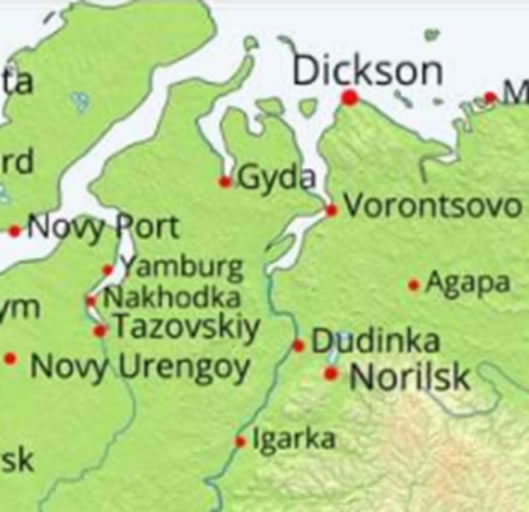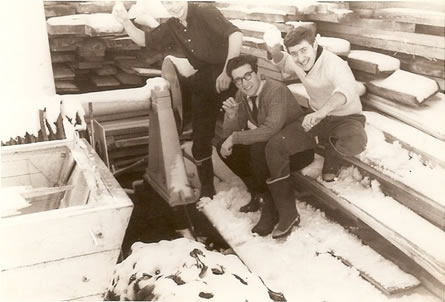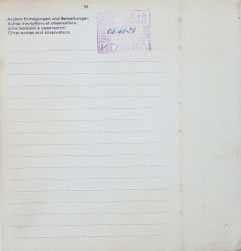
Launched on 16th July 1952 as NYON and delivered on 17th. October to Suisse-Atlantique Société de Navigation Maritime S.A., Lausanne., Bâle (Basel). Call sign HBFC. Length overall 136.39 meters, GRT: 4956, NRT: 2894, DWT: 9540.
1956 sold to Helica S.A., Genève (Management: Suisse-Atlantique Soc. d'Armement Maritime S.A., Lausanne), Bâle (Basel).
1956-1958 Management: Suisse Outremer S.A. de Gérance et d'Affretement Maritimes, Genève.
Went aground two miles north west of St. Abb's Head, east coast of Scottland on 15th November 1958 while on a ballast voyage from Leith to Dakar at about 19:06 hours.
The grounding took place unfortunately approximately 1.30 hours after high water. The forward part of the vessel resting on the three main ridges of rock. Water entered into the damaged holds no I, II, and III. Her stern was in deep water. On the 17th. November a contract on Lloyd's open form was signed with "Bureau Wijssmuller", after five days unsuccesfully attempts to free the vessel, it was decided on 20.11.1958 to cut the ship in two, just in front of the engine room bulkhead. Twenty three of the crew of thirty three were send ashore. It was said "half a ship is better than none". The stern half was freed on 27.11.1958 and arrived in tow of "Hector" and "Georg V" savely the River Tyne on 28th of November 1958.
After further strengthening, towed to Bolnes in Holland and Boeles S.W. & M.F., constructed a new forepart, which was joined to the stern part on 8th June 1959. Handed over to her owners in July 1959. The partly new NYON got now a length overall of 141.69 meters and a new gross tonnage of 5364 and 10'003 DWT.
The forepart resting on the rocks was destroyed totally in the winter gales a few days later after separation.
Sank five miles south of Beachy Head in a position 50°32' N 01°30' E on 15th. June 1962 after being in collision in fog with the Indian freigther "Jalazad" (6199/55). The 32 crewmembers abandoned savely the sinking NYON which sank within 14 minutes after the collison occurred. She was on a voyage from Antwerp and Bremen to Montreal fully loaded with general cargo.
![]()
Additional information and stories
Igarka, Siberia
The NYON sailed three times to Igarka, in 1957, 1959 and 1960, each time in the month of August, September, when the Yenisei River is ice-free. Igarka is about 360 nautical miles upriver, which is almost twice the distance than on the better known Mississippi to Baton Rouge. Also another company ship, the ST. CERGUE sailed to Igarka several times. The dictator Joseph Stalin died in March 1953, ice age still prevailed in the Moscow Kremlin and the world was divided into East and West. No one, especially no tourists, could visit Siberia; the few who usually got to know Siberia were German prisoners of war and political prisoners.

Igarka, on the Yenisei River
Igarka, a settlement of about 15,000 inhabitants founded in 1929, had sawmills and a small harbour to load ocean-going ships with sawn timber for export. Stalin had forced labourers build the "Polar Circle Railway", which ended in Igarka in the east. This railway was never completed and today is only partly operational. Even a naval base was planned in Igarka, but both projects were stopped after Stalin's death. From 1975 to 1980, Igarka experienced its heyday, about 1,200,000 m3 of timber per year were exported, making it the second largest timber port in the Soviet Union. A small airfield, located on an island, offers flight connections to Krasnoyarsk, Norilsk and Surgut. Thus, one can probably say that these trips by a foreign freighter to Igarka were something special at that time.
![]()
Personal account of steward Emil Gremaud
We were there with the NYON in September 1959 for about three weeks. Outward voyage in ballast to load sawn timber. We were moored at the buoys like the other two non-Russian ships, a Norwegian and a Spaniard.
Each of us received a copy of our passport in Cyrillic script, which consisted of two parts. Every Wednesday and Saturday we could go ashore with a local launch. We had to give one part of the passport to the guard on board. Igarka consisted of two parts. One was open, where the sailors' club and the sports hall were located. And an inner part, which was guarded by a three-metre-high board wall (comparable to a "Wild West" settlement).
Sitting on the back of a truck with our dirty ship's laundry, we entered the guarded part through a gate, where the laundry was located. The female soldier guarding the gate gave us a brisk military salute when we waved to her. The whole village was criss-crossed with canals in which the logs were transported to the sawmills. The streets were made of wooden planks, sometimes up to a metre above the ground to compensate for unevenness. Sometimes a piece of these planks was missing. Bad luck for the user if he was still on the road after midnight, because at midnight the generator was switched off and the lights went out.
On Wednesdays there was dance night in the sports hall, the whole thing was supervised by some elderly women. The music was played from LPs and tape, but only Russian tunes, so we agreed with the organiser (everything was organised by the command in the village) that we could bring a tape with our music (rock 'n' roll). From then on, everything went smoothly, we tried to teach the girls rock'n'roll steps.
There was a library in the sailors' club, and there was also a book in German called "Vom Leninismus über den Kommunismus zum Sozialismus" (From Leninism to Communism to Socialism) - the GDR sends its regards. The only food was bread with caviar, and to drink Armenian wine and, of course, vodka.
Back to our vessel, we had to use the launch again, and it could happen that the boat crew had already had too much vodka and the boat didn't move any more. Our Russian comrades helped us out, they were ashore with their own boat. They assured us that they would take us back to the NYON, but first we had to visit them on their ship. Visiting meant drinking a big glass of vodka with the whole ship's company. Back on our ship, we collected the second part of the passport from the guard.
The second part of the shore pass should not have been returned to those who came back after midnight. But that's how it went, you went to the watch man and said to him, "Comrade Zigaretti Amerikanski" and offered him a cigarette, whereupon he looked around, took a cigarette and offered me a Russian cigarette. After smoking together, everything was fine. Moscow is a long way from Igarka.
Once we had a football match with the team from Igarka (0 to 2 for Igarka), which of course had to be celebrated with four cases of beer. We couldn't get them through the control on shore, but again the Igarka superiors helped us, they sent a truck, which brought us and the beer to the sailors' club.
A nice memory was also the departure, when a Russian ship left, other vessels gave a farewell salute with the horn. That was also the case with us, but not with the other two foreign vessels. So we asked the captain to greet our vodka friends, when we passed. There were quite a few of them by now. He didn't do that, but that didn't stop our comrades from greeting us, and so our captain had no choice but to greet them as well. It's quite impressive to be seen off by a dozen ships like that. By the way, all the people I met here were always very nice.

Chief steward Billat, Eugen Steinmann and Emil Gremaud on the return trip from Igarka to London

Stamp from immigration Igarka in my seaman’s book
SwissShips, Emil Gremaud, HPS, April 2021